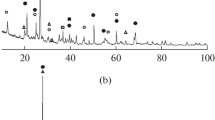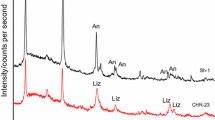Abstract
Sericite was K-depleted with molten LiNO3. The sample was changed into an interstratified structure in the presence of a small amount of LiNO3 after prolonged treatment, and in the presence of a considerable amount of LiNO3 a similar structure was formed after about 3 hr of reaction. In the case of the presence of the proper amount of NaCl, a mixed-layer structure was easily obtained by treatment for a long period of time with a considerable amount of molten LiNO3.
The interstratified mineral had a basal spacing of 22 Å–23·3 Å which was expanded to 25 Å–27·6 Å by treatment with ethylene glycol.
Résumé
Une séricite a été épuisée en potassium par LiNO3 fondu. L’échantillon a été transformé en une structure interstratifiée en présence d’une petite quantité de LiNO3 après un traitement prolongé; en présence d’une quantité importante de LiNO3. une structure similaire s’est formée après environ trois heures de réaction. Dans le cas où une quantitè appropriée de NaCI est présente, une structure interstratifiée a été facilement obtenue par un traitement de longue durée avec une quantité importante de LiNO3 fondu.
Le minéral interstratifié a un espacement basal de 22–23,3 Å, qui gonfle à 25–27,6 Å après traitement à l’éthylène-glycol.
Kurzreferat
Mit Hilfe von geschmolzenem LiNO3 wurde einem Sericit Kalium entzogen. In Gegenwart einer geringen Menge von LiNO3 wurde die Probe nach längerer Behandlung in ein zwischengeschichtetes Gefüge verwandelt, und in Gegenwart einer griösseren Menge von LiNO3 wurde ein ähnliches Gefüge bereits nach drei Stunden Reaktionszeit gebildet. Bei Anwesenheit der entsprechenden Menge von NaCl konnte eine Gemischtschichtstruktur leicht erhalten werden durch Behandlung über eine lämgere Zeitspanne mit einer beträchtlichen Menge von geschmolzenem LiNO3.
Das zwischengeschichtete Mineral hatte einen basalen Abstand von 22 Å–23,3 Å der durch Behandlung mit Äthylenglykol auf 25 Å–27,6 Å erweitert wurde.
Резюме
Серицит был подвергнут обработке расплавленным LiNO3 с целью удаления К. Образец претерпел превращение в смешаннослойную структуру в присутствии небольшого количества LiNO3 при продолжительной обработке или же в присутствии достаточно большого количества LiО3 в течение трех часов. В присутствии достаточного количества NаСl смешаннослойная структура легко получалась при обработке в течение длительного периода времени большим количеством расплавленного LiО3.
Смешаннослойный минерал характеризуется базальным межплоскостным расстоянием 22–23,3 0А, которое увеличивается до 25–27,6 0А при обработке этилен-гликолем.
Similar content being viewed by others
References
Barshad, I. (1948) Vermiculite and its relation to biotite as revealed by base exchange reactions, X-ray analyses, differential thermal curves and water content: Am. Mineralogist 33, 655–678.
Barshad, I. (1954) Cation exchange in micaceous minerals: Replaceability of ammonium and potassium from vermiculite, biotite and montmorillonite: Soil. Sci. 78, 57–76.
Brindley, G. W. (1956) Allevardite: Am. Mineralogist 41, 91–103.
De Mumbrum, L. E. (1959) Exchangeable potassium levels in vermiculite and K-depleted micas, and implications relative to potassium levels in soils: Soil Sci. Soc. Am. Proc. 23, 192–194.
De Mumbrum, L. E. (1963) Conversion of mica to vermiculite by potassium removal: Soil Sci. 96, 275–276.
Greene-Kelly, R. (1955) Dehydration of the montmorillonite minerals: Mineral. Mag. 30, 604–615.
Hanway, J. J. (1956) Fixation and release of ammonium in soils and certain minerals: Iowa State Coll. J. Sci 30, 374–375.
Jackson, M. L. and Sherman, G. D, (1953) Chemical weathering in soils: Advanc. Agron. 5, 219–318.
Mortland, M. M. (1958) Kinetics of potassium release from biotite: Soil Sci. Soc. Am. Proc. 22, 503–508.
Oinuma, K. and Hayashi, H. (1965) Infrared study of mixed-layer clay minerals: Am. Mineralogist 50, 1213–1227.
Rausell-Colom, J. A., Sweatman, C. B., Wells, C. B. and Norrish, K. (1965) In Experimental Pedology (Edited by E. G. Holdsworth and D. V. Crawford), pp. 40–72 Buttersworths, London.
Rich, C. I. and Cook, M. G. (1963) Formation of dioctahedral vermiculite in Virginia soils: Clays and Clay Minerals 10, 96–106.
Scott, A. D. (1968) Effect of particle size on interlayer potassium exchange in micas: Trans. 9th Cong. Int. Soil Sci. Soc. 2, 649–660.
Scott, A. D., Hunziker, R. R. and Hanway, J. J. (1960) Chemical extraction of potassium from soils and micaceous minerals with solutions containing sodium tetraphenylboron — I. Preliminary experiments: Soil Sci. Soc. Am. Proc. 24, 191–194.
Scott, A. D. and Reed, M. G. (1962a) Chemical extraction of potassium from soils and micaceous minerals with solutions containing sodium tetraphenylboron — II. Biotite: Soil Sci. Soc.Am. Proc. 26, 41–45.
Scott, A. D. and Reed, M. G. (1962b) Chemical extraction of potassium from soils and micaceous minerals with solutions containing sodium tetraphenylboron — III. Illite: Soil Sci. Soc.Am. Proc. 26, 45–48.
Stubican, V. and Roy, R. (1961a) A new approach to assignment of infrared absorption bands in layer-structure silicates: Z. Krist. 115, 200–214.
Stubičan, V. and Roy, R. (1962b) Isomorphous substitution and infrared spectra of the layer lattice silicates: Am. Mineralogist 46, 32–51.
Sudo, T., Hayashi, H. and Shimoda, S. (1962) Mineralogi-cal problems of intermediate clay minerals: Clays and Clay Minerals 9, 378–392.
Tettenhorst, R. and Johns, W. D. (1963) Interstratification in montmorillonite: Clays and Clay Minerals 13, 85–93.
Tomita, K. and Sudo, T. (1968a) Conversion of mica into an interstratified mineral: Rept. Faculty of Sci., Kagoshima Univ. No. 1, 89–119.
Tomita, K. and Sudo, T. (1968b) Interstratified structure formed from a pre-heated mica by acid treatments: Nature, Lond. 217, 2043–1044.
White, J. L. (1958) Layer charge and interlamellar lattice silicates: Clays and Clay Minerals 4, 133–146.
White, J. L. (1958) Layer charge and interlamellar expansion in a muscovite: Clays and Clay Minerals 5, 289–294.
Author information
Authors and Affiliations
Rights and permissions
About this article
Cite this article
Tomita, K., Sudo, T. Transformation of Sericite into an Interstratified Mineral. Clays Clay Miner. 19, 263–270 (1971). https://doi.org/10.1346/CCMN.1971.0190407
Received:
Published:
Issue Date:
DOI: https://doi.org/10.1346/CCMN.1971.0190407




